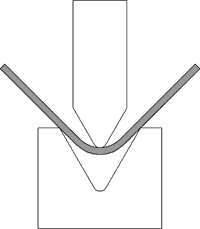Air bending is the most common type of 3 Types Of Bending used in sheet metal shops today. In this process the workpiece comes in contact with the outside edges of the die, as well as the punch tip. The punch is then forced past the top of the die into the v-opening without coming into contact with the bottom of the v. The v opening is typically deeper than the angle which is sought in the work piece. This allows for over bending to compensate for the Spring Back of the work piece. Typically Acute Angle Tooling can be used to fully air bend and 90 ° or 88 ° tooling can be used to partially air bend. There has recently been the introduction of 75 ° tooling to allow for full Air Bending, without the tooling restrictions of acute punches. (Acute punches are almost always knife dies with no goose-neck.)
Because the punch tip does not penetrate the workpiece the inside radius of the bend is controlled almost entirely by the size of the v opening of the bottom die. The larger the v opening the larger the radius. This means that the operator can control the radius of a bend even when working with the same material and thickness just by changing the bottom die. This can be used to compensate for errors in the layout or achieve a wider variety of design options. This is the reason why the inside radius of your finished product is not the same as your punch tip. If it is your intended goal to achieve a radius equal to your punch tip you will actually have to force the tip into the metal, this is known as Bottom Bending. Below you can see an example of Air Bending, notice there are only three points of contact.
This same versatility can work against you as well as it can lead to bad parts if the wrong Press Brake Dies are used. It is my recommendation that the dies you are using be clearly marked for their intended gauges and that using the larger dies to achieve larger radii be done only with knowledge of how it will affect the part. Be aware that you should never use smaller dies to bend heavier gauges due to the risk of damaging the die. For a list of radii compared to v openings refer to your Air Bend Force Chart. A further note on Air Bending is that it should almost never be used on older, mechanical, Brake Presses because of their inherent margin of error; even the difference of a few thousandths of an inch can result in bad parts. These press brakes are more suited for Bottom Bending and Coining.
Advantages Of Air Bending
Because the punch tip does not need to be forced past the surface of the metal much less tonnage is required to bend compared to Bottom Bending and Coining. This gives Air Bending a significant advantage in terms of tooling, both in geometry and longevity. Air bending also means that non specific tooling can be used, within reason, the inside radius is determined by the die width, not the punch tip.
